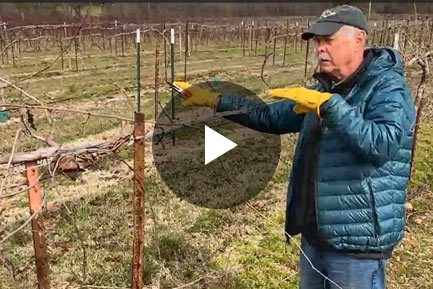The WOW! Grapes Farm
The Breeding Breakthrough
Jeff Bloodworth's lifelong quest to breed seedlessness into muscadine grapes started when he was a graduate research assistant at North Carolina State University. His original intent, like many before him, was to move disease resistance from muscadines into bunch grapes. His professor Dr. Bill Nesbitt was one of the first to have the idea of creating seedless muscadines. Jeff had full access to all of the muscadine varieties at NC State, so he started propagating them at his new farm in Hillsborough NC. Jeff had no idea how to start the process of creating a seedless muscadine, especially since the literature indicated that it was impossible, but this did not deter his desire to continue.
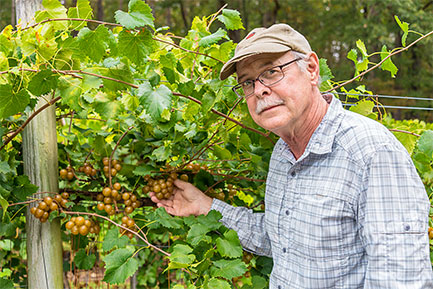
Jeff had an intermediate hybrid created in the past by another breeder. This hybrid had bunch grape and a little muscadine in its genes. It carried the seedless gene but did not express it, so it was seedy. He crossed this with another bunch grape and created a new seedless bunch grape. There were still just enough muscadine genes in the mix that he was then able to backcross this plant with another muscadine, and the rest is seedless muscadine history. It was not a quick process. It took over ten years to get to that point. It took even longer to start creating seedless muscadines with high enough fruit quality to start introducing them to the gardening world. More than 30 years later, Jeff is still working on breeding better muscadines.
Gurney's Joins the Cause.
By 2009, Jeff had created many seedless muscadines and was continuing to improve their quality. It was time to take his breeding program to the next level. By introducing seedlessness into muscadines, he more than proved himself to be an accomplished breeder, but releasing new varieties to the home gardeners and commercial growers would require a team of skilled people. Jeff invited breeders and researchers from colleges in the South with active breeding programs to view his work. Everyone was impressed but no deals were made with any of these institutions. In 2011, that was all about to change.
Our researchers at Gurney's heard about Jeff's breeding efforts. A visit to his vineyard during fruiting season sealed the deal. Gurney's, and our parent company Gardens Alive!, wanted to help. When we partnered with Jeff, seedling trials were moved to our Weeks Roses facility in California . With the team at Weeks tending to the daily maintenance of the vines, Jeff could focus solely on breeding. More than 15,000 seedlings were grown at Weeks over a 10-year evaluation period.
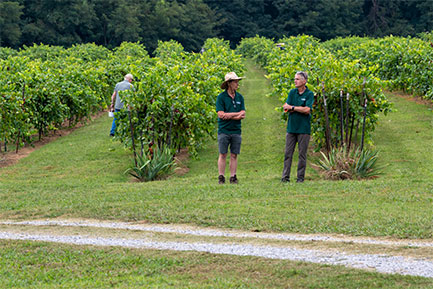
RazzMatazz®
After a partnership was formed, it did not take long before Gardens Alive! developed a plan to release the first grape from Jeff's program. Though not a true muscadine, RazzMatazz, is groundbreaking to say the least. Combining the sweet flavor and tender-crisp texture of table grapes with the disease resistance and native hardiness of muscadines, RazzMatazz is the first seedless grape to provide gardeners with true fruiting success without spraying. It's also the first ever continuously fruiting grape, setting blooms and fruit all summer. While most varieties produce three or four clusters of grapes per shoot, RazzMatazz delivers up to 24 clusters on each shoot!
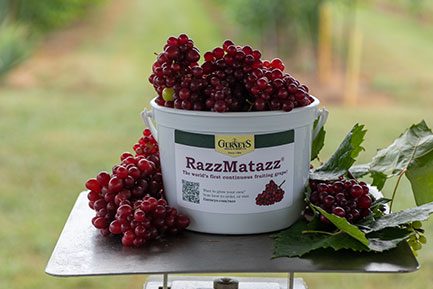
Passing the Baton
The special process used to produce the first seedless muscadine grapes is protected by a United States utility patent. Anyone who wants to breed seedless muscadines must be licensed by Gardens Alive!. As our grape breeder Jeff Bloodworth nears retirement, it was important for us to find the right partner to continue seedless muscadine breeding. We did not have to look far. The University of Arkansas was the obvious choice--their berry and grape breeding programs have been leaders in the industry for many years.
University of Arkansas—Past, Present and Future
Since its founding, the University of Arkansas fruit breeding program has made significant impacts locally and globally. Its founder, Jim Moore, worked extensively with grapes, blackberries, peaches, strawberries and blueberries, and the fruits of his breeding labor can be found on every continent but Antarctica. Before retiring, Jim mentored his successor, John Clark, for many years. Clark's blackberry breeding changed the industry, transitioning from a local crop to one with international importance. Now the current department head, Margaret Leigh Worthington, is poised to bring seedless muscadines to the international stage and make them a mainstay of American tables.
The WOW! Grapes Farm
The WOW! Grapes Farm, located in Kings Mountain NC, is now the center for seedless muscadine research and production. Formerly known as Killdeer Farms and owned by the late Ervin Lineberger, this location has long been the leader in developing the best methods for growing muscadine grapes. After being introduced to Jeff Bloodworth, Ervin knew that seedlessness was the future of the crop. He quickly agreed to trial Jeff's seedless selections and had a knack for figuring out what each selection needed to grow and produce to its fullest. It was only natural that Gardens Alive! purchase Ervin's farm after he passed away. All of Jeff's new hybrid seedlings are sent there from the Weeks facility for evaluation. Once superior selections are identified, more of those plants are produced and planted out in larger blocks at the farm. These are evaluated further and best practices are developed for producing high-quality fruit.
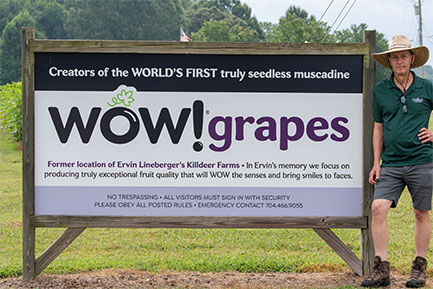
What is a Muscadine?
Muscadines (Vitis rotundifolia) is a species of grape native to the southeastern United States. Thriving in warm, humid conditions, muscadine vines can be found along the East Coast from southern Delaware down to central Florida, as far west as Texas and Oklahoma and everywhere in between. Muscadines are tall-growing vines that are often found along roadsides, dry woods, swamps and river bottoms. The fruit of wild muscadines is usually dark purple to black and sometimes greenish amber. Fruits are primarily eaten by mammals in the wild and not usually birds.
What is a Scuppernong?
The Scuppernong is a greenish-gold muscadine originally found in the 1700s growing in the Scuppernong River area of North Carolina. Originally named The Big White Grape, this famous variety is said to have been grown by nearly every family in the area. It's even the subject of prose, poetry, and wine. It is also the state fruit of North Carolina.
Revered by the Earliest Americans
Long before European settlers arrived, native cultures were using muscadines in many forms. They made raisins, drinks, and other food items with them and also used them medicinally and for dyes. Early European explorers were amazed at the abundance of grapes when they landed on what are now the shores of Virginia and the Carolinas, and it is reported that the Spanish missionaries in Florida were making wine as early as 1565. The earliest muscadine varieties were selections from wild plants, and the oldest known known vine is on Roanoke Island. This Scuppernong plant, known as the mother vine, is over 200 years old. At one time, the sprawling vine occupied two acres of land, and some consider it to be the oldest grapevine in eastern North America.
Disease Resistance
Muscadine grapes are well known for their natural tolerance to many common grape diseases that plague bunch grapes. For instance, they are resistant to downy mildew, Pierce's disease and anthracnose. Depending on the variety, they also show very good resistance to powdery mildew. Other diseases, such as black rot, can occur on muscadine vines and fruit, however, the results are not nearly as destructive as they would be on bunch grapes.
Flower Fertility and Muscadine Breeding
Muscadine grapes in the wild have either male or female flowers on the vine. This means if you are growing a female variety, you will need a male vine to pollinate it. Even though one male can pollinate up to three female plants, this can be problematic since the male vines take up space in the vineyard without producing any fruit. In the early 1900s, muscadine breeding programs initiated by the USDA and several universities sought to improve fruit quality and to produce a plant with both male and female reproductive parts on the same flower. This would eliminate the need for male plants and increase the overall productivity of muscadine vineyards.
Why Are Seedless Grapes Seedless?
Hang on to your hats—seedless grapes are not really seedless. They actually have a remnant of a seed that is rarely detected by the consumer. This is a natural mutation and occurs because of a process called stenospermocarpy. When the grape flowers are pollinated and the seeds start to grow, stenospermocarpy puts a halt on the process, and what should have been the seed ends up as a very small vestige called a seed remnant.
Where did Seedless Grapes Originate?
The seedless trait was first discovered a very long time ago in Asia Minor. It was not found in muscadines but in the better-known Eurasian bunch grapes (Vitis vinifera), which includes wine grapes such as Cabernet Sauvignon, Chardonnay and Merlot and the table grapes you buy in the grocery store. The original seedless variety, Thompson Seedless, was brought to California from the Middle East, where it is known as Sultana.
Two Grapes, Worlds Apart
Even though they are related, and both called grapes, it is hypothesized that muscadine and bunch grapes diverged from a common ancestor roughly 18 million years ago. Existing in reproductive isolation over eons, they evolved into two very different forms of grape. Bunch grapes have clusters of grapes that ripen at the same time while muscadine fruits ripen individually. Muscadines have a strong musky flavor and thick skins. Bunch grapes have thin skins and milder flavor. Bunch grapes are very disease prone. Muscadines are very disease resistant.
Seedless Muscadines—Achieving the Impossible
Over many decades, breeders have tried to introduce the seedlessness of bunch grapes into muscadine grapes. Plants (like animals) erect barriers to mating with unrelated life forms and muscadine grapes exhibit such a barrier with bunch grapes. The biggest hurdle has been the chromosome numbers of each grape type. They are distant relatives that do not cross pollinate easily. When they are successfully crossed, the offspring were always sterile and no grapes were produced. Most breeding programs gave up attempting to introduce seedlessness into muscadines, determining it was nearly impossible.
Have another question? Return to the Customer Service Help page or send an e-mail directly to Customer Service





 Gardens Alive! & Supplies
Gardens Alive! & Supplies





